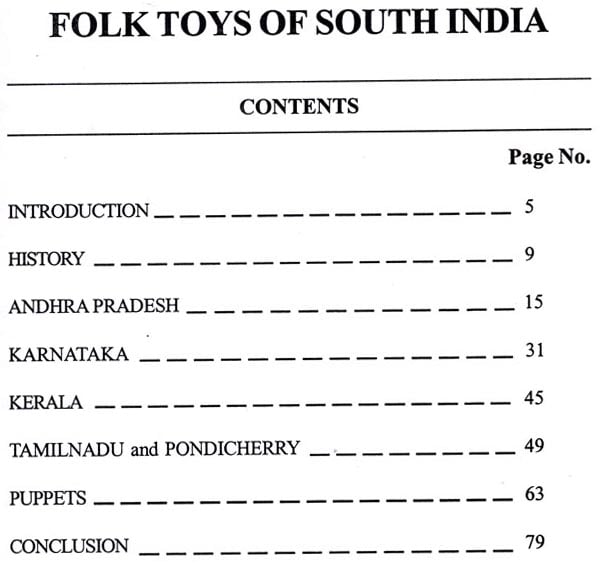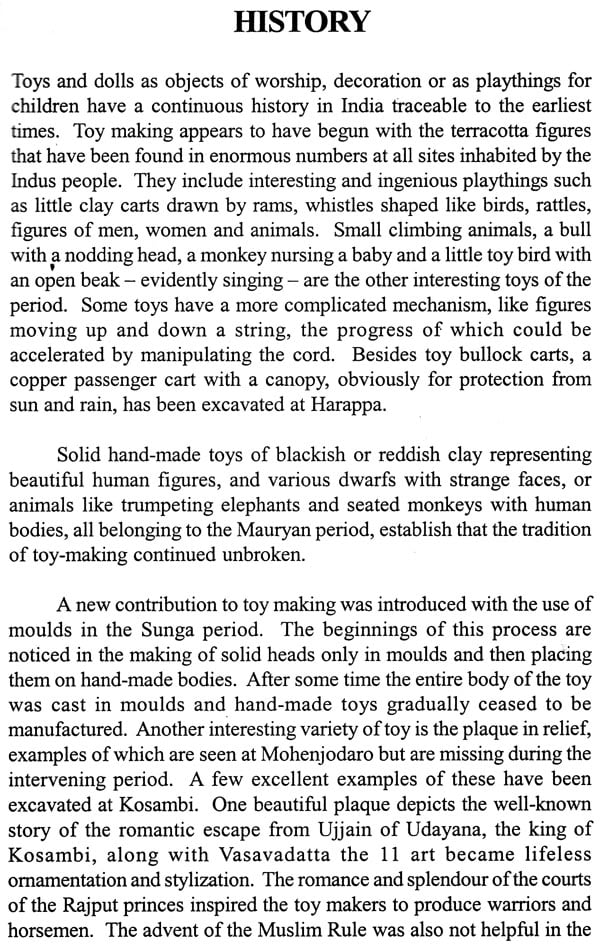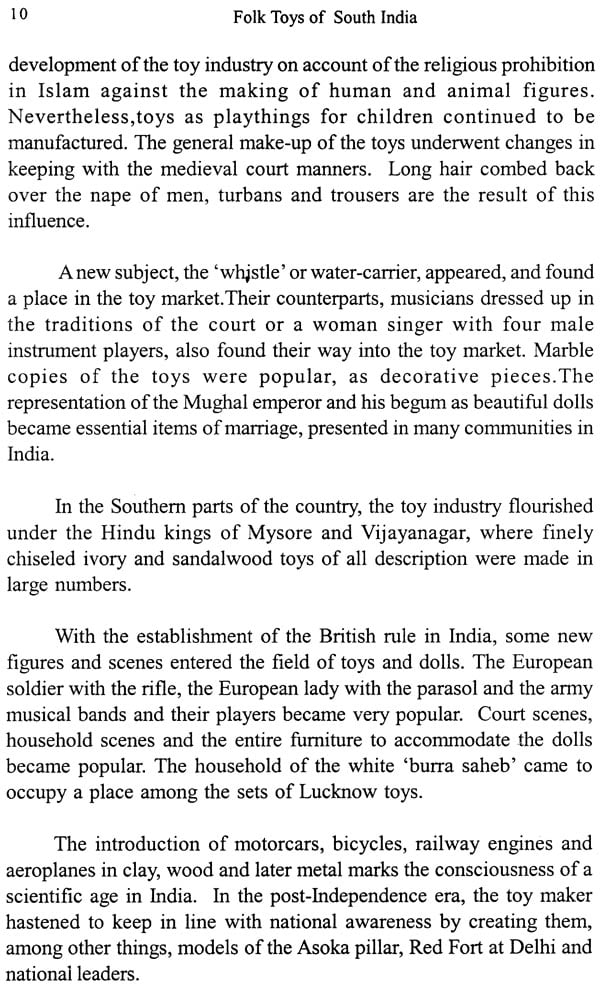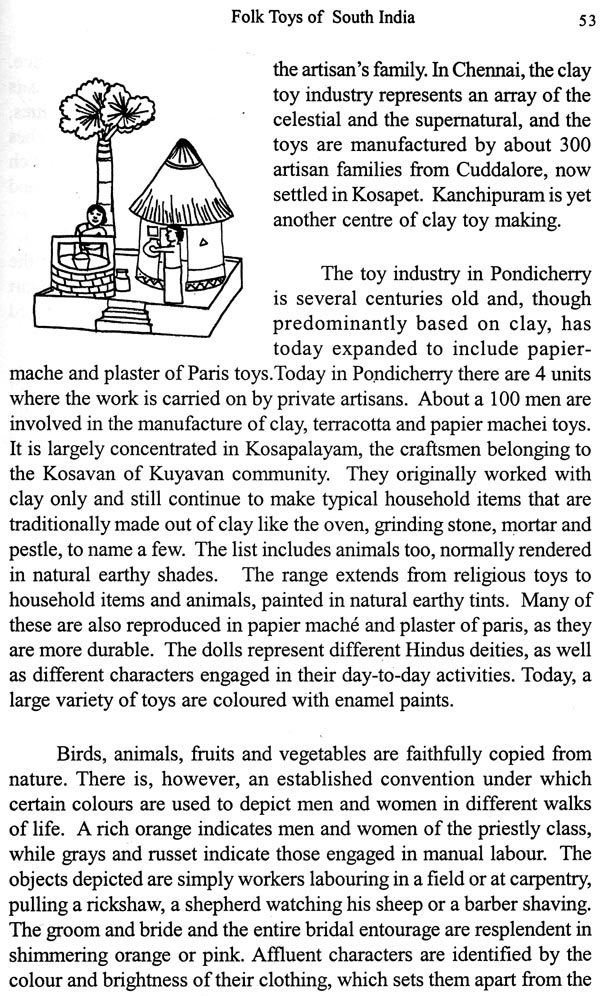
Folk Toys of South India
Book Specification
| Item Code: | NAU187 |
| Author: | Nanditha Krishna |
| Publisher: | The C. P. Ramaswami Aiyar Foundation, Chennai |
| Language: | English |
| Edition: | 2006 |
| ISBN: | 8190148494 |
| Pages: | 79(54 Color 25 B/W Illustrations) |
| Cover: | PAPERBACK |
| Other Details | 8.50 X 5.50 inch |
| Weight | 150 gm |
Book Description
The wide panorama of Indian folk toys speaks of the heritage of the people, a heritage re-created in almost every existent material, constituting a range that is almost incredible in its diversity. And yet, underlying this rich variety, the keynote is the Indian craftsman's desire to capture and reproduce the indigent folk spirit into a tangible whole in ways that never cease to delight the one person for whom it has been exclusively designed - the Indian child.
Thus, even as one gains an insight into the bewitching world of South Indian folk toys, one observes that is imbued with a spirit that is purely rural. Against this backdrop of a unity in purpose, theme and spirit, one endeavours to understand the meaning of the various folk toys, whether they are of wood, clay, terracotta, palm, saw dust, or metal. Generally speaking, in the South of India, perhaps the most extravagant array of toys are those created by the artists of Andhra Pradesh. Although the Kondapalli, Nirmal and Ettikoppaka toys are almost synonymous with the Andhra Pradesh toy industry, the latter owes its reputation to toys which boast of a unique folk splendour. But what the other states lack in quantity is made up by a uniqueness of conception, skilled design and mastery in execution. Whether they are the clay toys of Pondicherry and Kancheepuram, the world famous lacquer ware of Chennapatna or the fresh, spontaneous, palm toys of Kerala, the folk spirit is so dynamic and powerfully represented that the toy at times ceases to be a toy. It seemingly lives. The irony is that, although toys are the fruits of fantasy, they take the child closer to the world of reality.
Since wood plays a very important part in the folk toy industry, some light must be thrown on the folk tradition of wood carving which finds expression in the manufacture of several toys and ritual objects associated with the life of the people. A number of folk forms have been developed in wood all over India. These can be divided into figures made for religious purposes, such as the Jagannath figures of Orissa, wooden masks or Saki Jaba, the variety of Andhra toys of softwood used for producing vahanas of different gods reproduced at the Nirmal village and Kondapalli and the temple towns of Tanjore and Madurai. Also included are the tribal carvings of Bastar. Light wooden toy animals and birds as well as occupational figures are prepared all over the South. These miniature toys, recreating the real and imaginary worlds, bring joy to children as also a sense of identification with the world of adults. These toys are indeed an indispensable part of the child's life. The Tirupathi and Thanjavur dolls thus not only form part of the rituals observed by the South Indian families but are also used for educating the child, who sees them every day, who handles them and assists his or her mother on special occa-sions to dress them up for festivals.
Change in Demand Pattern
Historically, the survival and growth of these industries were, for the most part, dependent on the patronage of the rich feudal society, although the toys were purchased by rich and poor alike. The rapid social changes in recent decades, particularly after the attainment of independence and the growth of the urban industrial society, have brought in their trail changes in the pattern of demand. Handicrafts and handlooms have acquired added importance by registering phenomenal gains in the field of export. Various measures were initiated under the Five Year Plans, whether in the matter of promoting institutions, setting up design development centres, technical improvements, training, product innovation and diversification, quality control or marketing. The broad guiding factor has been that since goods are produced for sale it should be the endeavour of the state to secure the maximum degree of public acceptance, both within the country and abroad.
The arrival in the market of more sophisticated mechanical, battery-operated and electronic toys have relegated the traditional toys to the role of a decorative craft item rather than a useful cultural toy to be used by children.
Design Development
The need for design assistance as an important vehicle of handicrafts has been recognized from the beginning. Keeping in view the existence of a large number of handicraft centres in India, several design centres were set up in the country. Simultaneously, the handicrafts units have also been availing the assistance offered by the Regional Design Centre of the Office of the Development Commissioner for Handicrafts (formerly All India Handicrafts Board) at Bangalore. It has been the endeavour of the design centres to impart utility and content to the traditional forms through the process of designing and redesigning. By working in close coordination with the emporia, the design centres have made the benefits of their work reach the artisans and the public at large more quickly. The Design Centre at Hyderabad is also engaged in doing research on tools and techniques.
Exports
Overseas trading in Indian handicrafts dates back to times immemorial. Post-independence, since the commencement of the Five Year Plans, interest in export has revived. There has been a greater stimulus to export handicrafts from all parts of the country, resulting in a diversification of production. The total handicrafts export earnings increased from Rs. 10,933.67 crores in 2002-3 to Rs. 13412.92 crores in 2005-6. Unfortunately, we do not have separate figures for toys, which may come under items made of metal, wood or other materials.
Survival
Folk toys are under increasing pressure, unable to compete with the onslaught of metal, plastic and imported toys, which have the advantage of both quantity and quality. Earlier, the temple festivals and village fairs were the mecca of traditonal toy makers of every hue. Today, even the traditional outlets have been supplanted by branded varieties, leaving the tradition toys as a curio to be placed in a showcase.
**Contents and Sample Pages**










